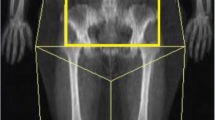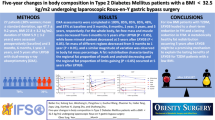Abstract
Background
Our aim was to monitor the impact of Roux-en-Y gastric bypass (RYGBP) on body composition over a 24-month period by dual-energy X-ray absorptiometry (DXA).
Methods
Forty-one women (40.6 ± 10.0 years old; 42.6 ± 6.6 kg/m2) entering a bariatric surgery programme were submitted to whole-body DXA (Lunar iDXA) before treatment and after 3, 6, 12 and 24 months. Fat mass (FM), non-bone lean mass (LM), bone mineral content (BMC) and density (BMD) were measured at whole body and regionally. Android visceral adipose tissue (VAT) was estimated by a recently validated software.
Results
Twenty-nine patients (44.3 ± 11.8 years old; BMI, 45.4 ± 8.9 kg/m2) concluded the study. Following surgery, the progressive decrease of BMI was associated with reduced whole-body and regional FM. LM showed a moderate decrease at 3 months and stabilized thereafter. A progressive decrease of total FM/LM and android FM/LM ratios were observed in the 3- to 6-month (−19.1 ± 8.4 % and −26.5 ± 10.9 %, respectively; p < 0.0001) and 6- to 12-month periods (−23.5 ± 16.8 % and −29.4 ± 23.9 %, respectively; p < 0.0001). VAT was the parameter showing the largest decrease (−65.6 ± 17.5 % at 12 months; p < 0.0001). Two years after the surgery, a slight but significant decrease of total and regional LM was observed, without any significant change in BMI.
Conclusions
Body composition significantly changes after RYGBP with a metabolically healthier redistribution of total and regional FM and a positive balance of FM/LM variation. DXA should be considered as a valid supplementary tool for the clinical assessment and follow-up in patients undergoing bariatric surgery.



Similar content being viewed by others
References
World Health Organization. Fact Sheet No 311 Obesity and Overweight. Geneva Ahwwimffe.
Wang YC, McPherson K, Marsh T, et al. Health and economic burden of the projected obesity trends in the USA and the UK. Lancet. 2011;378(9793):815–25.
Despres JP, Lemieux S, Lamarche B, et al. The insulin resistance-dyslipidemic syndrome: contribution of visceral obesity and therapeutic implications. Int J Obes Relat Metab Disord. 1995;19 Suppl 1:S76–86.
Tran TT, Yamamoto Y, Gesta S, et al. Beneficial effects of subcutaneous fat transplantation on metabolism. Cell Metab. 2008;7(5):410–20.
Taksali SE, Caprio S, Dziura J, et al. High visceral and low abdominal subcutaneous fat stores in the obese adolescent: a determinant of an adverse metabolic phenotype. Diabetes. 2008;57(2):367–71.
Ravussin E, Smith SR. Increased fat intake, impaired fat oxidation, and failure of fat cell proliferation result in ectopic fat storage, insulin resistance, and type 2 diabetes mellitus. Ann N Y Acad Sci. 2002;967:363–78.
Leff DR, Heath D. Surgery for obesity in adulthood. BMJ. 2009;339:b3402.
Cariani S, Amenta E. Three-year results of Roux-en-Y gastric bypass-on-vertical banded gastroplasty: an effective and safe procedure which enables endoscopy and X-ray study of the stomach and biliary tract. Obes Surg. 2007;17(10):1312–8.
Leuratti L, Di Simone MP, Cariani S. Unexpected changes in the gastric remnant in asymptomatic patients after Roux-en-Y gastric bypass on vertical banded gastroplasty. Obes Surg. 2013;23(1):131–9.
U.S. Department of Health and Human Services. Physical activity and health: a report of the surgeon general. Atlanta GUSDoHaHS.
De Lorenzo A, Bianchi A, Maroni P, et al. Adiposity rather than BMI determines metabolic risk. Int J Cardiol. 2013;166(1):111–7.
Bazzocchi A, Diano D, Ponti F, et al. Health and ageing: a cross-sectional study of body composition. Clin Nutr. 2013;32(4):569–78.
Verdich C, Barbe P, Petersen M, et al. Changes in body composition during weight loss in obese subjects in the NUGENOB study: comparison of bioelectrical impedance vs. dual-energy X-ray absorptiometry. Diabetes Metab. 2011;37(3):222–9.
Malina RM. Body composition in athletes: assessment and estimated fatness. Clin Sports Med. 2007;26(1):37–68.
St-Onge MP. Relationship between body composition changes and changes in physical function and metabolic risk factors in aging. Curr Opin Clin Nutr Metab Care. 2005;8(5):523–8.
Gastrointestinal surgery for severe obesity: National Institutes of Health Consensus Development Conference Statement. Am J Clin Nutr. 1992;55(2 Suppl):615S–9S.
Libber J, Binkley N, Krueger D. Clinical observations in total body DXA: technical aspects of positioning and analysis. J Clin Densitom. 2012;15(3):282–9.
Rothney MP, Brychta RJ, Schaefer EV, et al. Body composition measured by dual-energy X-ray absorptiometry half-body scans in obese adults. Obesity (Silver Spring). 2009;17(6):1281–6.
Micklesfield LK, Goedecke JH, Punyanitya M, et al. Dual-energy X-ray performs as well as clinical computed tomography for the measurement of visceral fat. Obesity (Silver Spring). 2012;20(5):1109–14.
Sjostrom L, Peltonen M, Jacobson P, et al. Bariatric surgery and long-term cardiovascular events. JAMA. 2012;307(1):56–65.
Bazzocchi A, Diano D. Dual-energy x-ray absorptiometry in obesity. CMAJ. 2013;186(1):48.
Kendler DL, Borges JL, Fielding RA, et al. The Official Positions of the International Society for Clinical Densitometry: indications of use and reporting of DXA for body composition. J Clin Densitom. 2013;16(4):496–507.
Chaston TB, Dixon JB, O’Brien PE. Changes in fat-free mass during significant weight loss: a systematic review. Int J Obes (Lond). 2007;31(5):743–50.
Dixon JB, Strauss BJ, Laurie C, et al. Changes in body composition with weight loss: obese subjects randomized to surgical and medical programs. Obesity (Silver Spring). 2007;15(5):1187–98.
Vatier C, Henegar C, Ciangura C, et al. Dynamic relations between sedentary behavior, physical activity, and body composition after bariatric surgery. Obes Surg. 2012;22(8):1251–6.
Tamboli RA, Hossain HA, Marks PA, et al. Body composition and energy metabolism following Roux-en-Y gastric bypass surgery. Obesity (Silver Spring). 2010;18(9):1718–24.
Carrasco F, Ruz M, Rojas P, et al. Changes in bone mineral density, body composition and adiponectin levels in morbidly obese patients after bariatric surgery. Obes Surg. 2009;19(1):41–6.
Zalesin KC, Franklin BA, Lillystone MA, et al. Differential loss of fat and lean mass in the morbidly obese after bariatric surgery. Metab Syndr Relat Disord. 2010;8(1):15–20.
Gasteyger C, Suter M, Calmes JM, et al. Changes in body composition, metabolic profile and nutritional status 24 months after gastric banding. Obes Surg. 2006;16(3):243–50.
Giusti V, Suter M, Heraief E, et al. Effects of laparoscopic gastric banding on body composition, metabolic profile and nutritional status of obese women: 12-months follow-up. Obes Surg. 2004;14(2):239–45.
Garrapa GG, Canibus P, Gatti C, et al. Changes in body composition and insulin sensitivity in severely obese subjects after laparoscopic adjustable silicone gastric banding (LASGB). Med Sci Monit. 2005;11(11):CR522–8.
von Mach MA, Stoeckli R, Bilz S, et al. Changes in bone mineral content after surgical treatment of morbid obesity. Metabolism. 2004;53(7):918–21.
Rojas P, Carrasco F, Codoceo J, et al. Trace element status and inflammation parameters after 6 months of Roux-en-Y gastric bypass. Obes Surg. 2011;21(5):561–8.
Conflict of Interest
All the authors have no conflict of interest to declare.
Statement of Informed Consent
Informed consent was obtained from all individual participants included in the study.
Statement of Human and Animal Rights
All procedures performed in studies involving human participants were in accordance with the ethical standards of the institutional and/or national research committee and with the 1964 Helsinki declaration and its later amendments or comparable ethical standards.
Author information
Authors and Affiliations
Corresponding author
Rights and permissions
About this article
Cite this article
Bazzocchi, A., Ponti, F., Cariani, S. et al. Visceral Fat and Body Composition Changes in a Female Population After RYGBP: a Two-Year Follow-Up by DXA. OBES SURG 25, 443–451 (2015). https://doi.org/10.1007/s11695-014-1422-8
Published:
Issue Date:
DOI: https://doi.org/10.1007/s11695-014-1422-8




